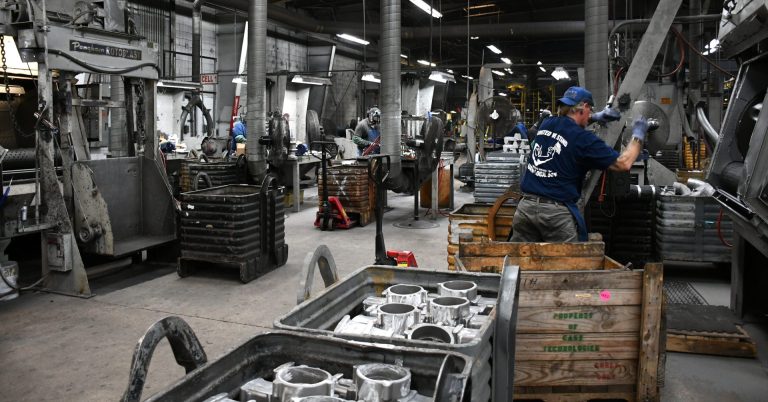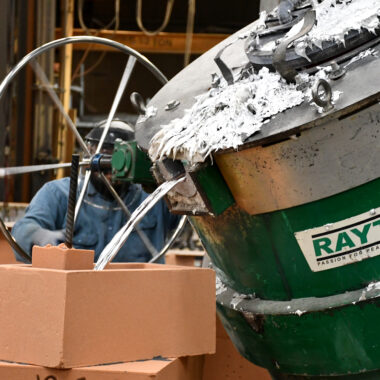Aluminum Casting Demystified: Trick Methods for Success
Aluminum Casting Demystified: Trick Methods for Success
Blog Article
Dive Into the Globe of Light Weight Aluminum Casting: Comprehending the Various Approaches
Aluminum spreading is a basic process in the manufacturing sector, with different approaches employed to develop accurate and elaborate parts. Recognizing the various methods utilized in light weight aluminum casting can supply useful insights right into the abilities and limitations of each method. From the typical sand casting technique to the advanced die spreading process, each technique provides unique advantages depending on the requirements of the task. Exploring these varied approaches can provide a detailed sight of the opportunities within the globe of light weight aluminum casting and just how each technique adds to forming the modern-day manufacturing landscape.
Sand Spreading Technique
Sand casting, a widely-used method in aluminum casting procedures, includes creating mold and mildews made of compressed sand for putting molten metal. As soon as the mold is prepared, it is safely positioned in a flask and molten aluminum is put into the tooth cavity.
After the steel has actually cooled and solidified, the sand mold is broken away to expose the light weight aluminum spreading. Sand casting enables for the manufacturing of complicated forms and large parts that may be difficult or costly to create making use of other techniques. It is additionally a lasting technique as the sand can be recycled and made use of multiple times, reducing waste in the spreading process.
Irreversible Mold And Mildew Technique

One significant advantage of the Irreversible Mold Strategy is the improved dimensional precision it provides. The metal mold and mildew enables tighter tolerances and finer details in the last aluminum castings compared to sand spreading methods. This accuracy makes it a favored choice for applications where limited dimensional control is crucial, such as in the aerospace and automotive markets.

Pass Away Casting Process

Investment Casting Strategy
Using a precision spreading approach, Investment Casting Strategy involves producing detailed aluminum elements by pouring molten steel into a ceramic mold and mildew. This procedure, also referred to as lost-wax spreading, starts with the creation of a wax pattern of the desired part. This wax pattern is after that covered with a ceramic product to develop a covering. As soon as the ceramic shell is hardened, it is warmed to eliminate the wax, leaving a hollow ceramic mold.
Financial investment spreading is frequently utilized for manufacturing parts in industries where limited tolerances and complex styles are required, such as aerospace, auto, and medical tools. The versatility and precision of the Investment Casting Technique make it a beneficial strategy in other the globe of aluminum casting.
Lost Foam Spreading Approach
Having discovered the intricate precision of Investment Casting Method, the focus currently changes to the cutting-edge method of Lost Foam Casting in aluminum element production. Lost Foam Casting, additionally referred to as evaporative pattern spreading, is a modern-day strategy where a foam pattern of the desired part is created and after that coated with a refractory product. The coated foam pattern is after that hidden in sand, and molten aluminum is put right into the mold and mildew. As the metal fills the mold and mildew, the foam evaporates due to the warmth, leaving a tidy cavity in the form of the wanted part.
Furthermore, Lost Foam Casting is a cost-efficient procedure as it decreases the need for cores and permits for the production of lightweight elements. In spite of its benefits, Lost Foam Casting needs careful control of the spreading process to guarantee and stop issues quality components.
Verdict
Finally, aluminum spreading provides a selection of approaches such as sand spreading, irreversible mold and mildew strategy, die casting, investment casting, and shed foam spreading. Each approach has its own advantages and applications, making light weight aluminum casting a versatile and widely made use of procedure in different markets. Comprehending the distinctions in between these techniques is check out here important in choosing the most appropriate casting technique for certain manufacturing requirements.
Sand spreading, a widely-used method in light weight aluminum casting procedures, involves producing molds made of compacted sand for putting molten steel. aluminum casting.The Permanent Mold Strategy, like sand casting, is another prevalent approach utilized in aluminum spreading procedures, offering unique advantages in terms of mold reusability and dimensional accuracy. The steel mold and mildew permits for tighter tolerances and better details in the final light weight aluminum castings compared to sand spreading approaches. The 2 main kinds of die casting are cold chamber die spreading and warm chamber die spreading, each suitable for various kinds of aluminum alloys.In conclusion, aluminum casting provides a variety of techniques such as sand spreading, permanent mold and mildew strategy, see this page die casting, financial investment spreading, and lost foam casting
Report this page